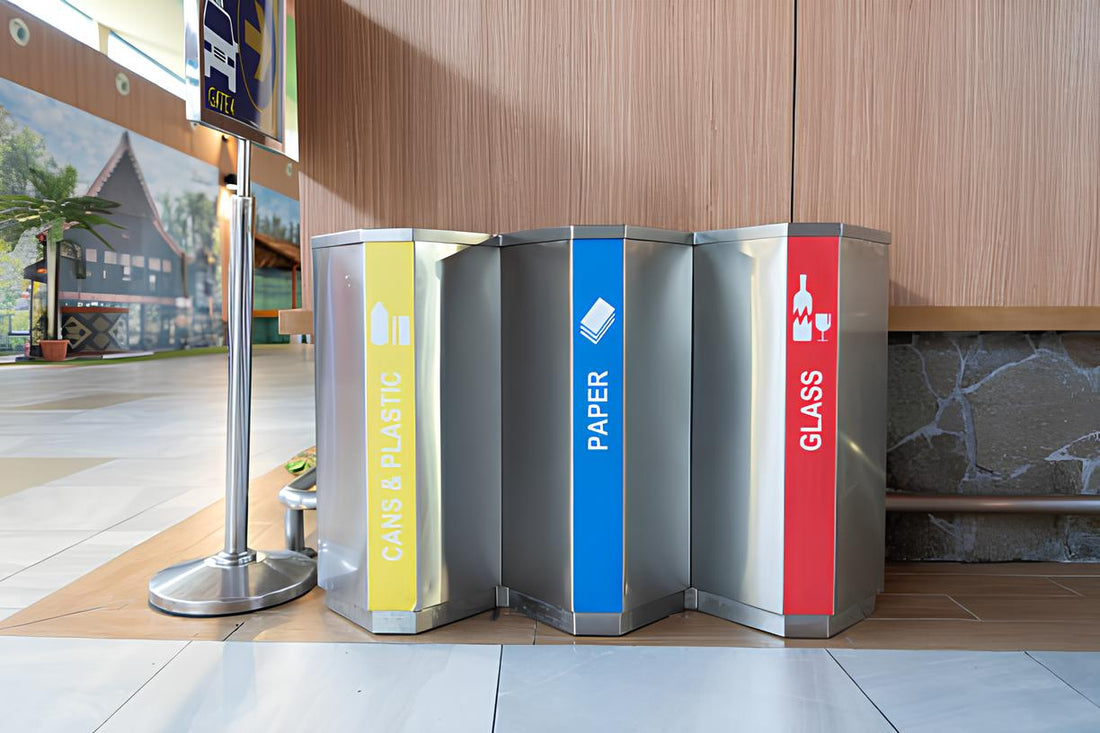Selecting the right trash bin size for hotel public spaces directly impacts operational costs. The difference between a 13-gallon and 23-gallon receptacle might seem minor, but placement density and capacity choices affect labor hours, waste management efficiency, and guest experience.
Understanding commercial bin sizing helps property managers optimize cleaning schedules and reduce unnecessary expenses.
The Hidden Cost of Wrong-Sized Commercial Bins
Undersized bins in high-traffic areas create cascading problems. Overflow forces housekeeping staff to make unscheduled rounds, disrupting planned workflows.
According to hospitality waste statistics, hotels worldwide produce approximately 289,700 tonnes of waste annually. Properties using inadequate bin capacity in public spaces allocate 25-40% more labor hours to waste management than properly-sized alternatives.
Visible overflow damages guest perception immediately. Overflowing lobby bins signal poor maintenance standards—a detail that frequently appears in negative online reviews.
Oversized bins present different challenges. Cleaning staff must service them on fixed schedules regardless of fill level. Half-empty 23-gallon bins require the same labor time as full ones, wasting resources on unnecessary trips.
The optimal approach matches bin capacity to actual waste generation rates. This eliminates both overflow incidents and wasted service rounds.
Right-Sizing Strategy: Calculate Your Daily Waste Output

Accurate capacity planning starts with observation. Monitor high-traffic bins for one full week during typical occupancy periods.
Assessment Method:
- Record bin fullness at each scheduled service time
- Note how many hours it takes to reach 80% capacity
- Track variations between weekday and weekend patterns
- Document any overflow incidents
Example: A hotel lobby bin reaches 90% fullness in 6 hours during weekdays. With three daily service rounds, a 16-gallon capacity provides adequate margin. If that same location only fills to 50% in 6 hours, downgrading to 13 gallons optimizes efficiency.
Different zones require different capacities. Entrance areas with coffee service generate more waste than corridor locations. Pool deck bins fill faster during summer months than winter.
Calculate service frequency alongside capacity. A 13-gallon bin serviced every 4 hours handles the same volume as a 20-gallon bin serviced every 6 hours. The choice depends on available labor scheduling and foot traffic patterns.
Seasonal adjustments matter. Properties that host summer conferences or holiday events need flexible planning. Some facilities temporarily add extra bins during peak periods rather than permanently oversizing all locations.
Why Steel Outdoor Trash Cans Deliver Superior ROI

Material selection significantly impacts long-term costs. While steel receptacles carry higher upfront prices, their durability and weather resistance deliver superior value over time.
Material Comparison: 10-Year Cost Analysis
| Factor | Heavy-Duty Plastic | Powder-Coated Steel | Stainless Steel |
|---|---|---|---|
| Initial Cost (per unit) | $120 | $200 | $280 |
| Average Lifespan | 2.5 years | 10-12 years | 12-15 years |
| Replacements Needed (10 years) | 4 units | 1 unit | 1 unit |
| Total 10-Year Cost | $480 | $200 | $280 |
| Annual Cost (15 units) | $720 | $300 | $420 |
| Weather Resistance |
Poor UV degradation |
Excellent | Superior |
| Impact Resistance |
Moderate Cracks easily |
High | Very High |
| Maintenance | Low (until failure) |
Minimal | Regular cleaning |
| Aesthetic Longevity |
Poor Fades within 18 months |
Excellent Maintains finish |
Premium Premium throughout |
The economics are clear: A property with 15 public area waste stations saves $420-600 annually by choosing steel over plastic—a 58-83% cost reduction over the product lifecycle.
Weather resistance becomes critical for outdoor or semi-outdoor placements. Plastic bins exposed to UV radiation become brittle, developing cracks around stress points. Research on commercial equipment lifecycle expectations shows that properly maintained metal waste receptacles typically have a useful life of 20-25 years.
Steel maintains structural integrity through temperature fluctuations and physical impacts without compromising function or appearance. This reliability matters for brand standards in hospitality environments where visual consistency reflects operational quality.
Lockable Containers: Security, Pest Control & Compliance
Lockable mechanisms on commercial bins address multiple operational challenges simultaneously. They prevent unauthorized dumping, restrict pest access, and support regulatory compliance.
Unauthorized dumping by non-guests or neighboring businesses increases disposal volumes and costs. Unlocked bins in semi-public spaces invite misuse. Lockable receptacles eliminate this issue without requiring constant monitoring.
Secure lids block access for rodents, birds, and insects. Open bins in outdoor areas attract pests that create hygiene concerns and require professional control services. Properties in urban settings report 65-75% fewer pest-related complaints after installing locking mechanisms.
Health code compliance in food service areas often mandates secure waste storage. Most jurisdictions follow EPA waste management guidelines that specify bins must prevent pest access and unauthorized removal of contents. Lockable containers provide straightforward compliance documentation during inspections.
Modern locking systems offer operational flexibility. Gravity-lock designs allow users to deposit waste through top openings while preventing removal—ideal for guest-accessible locations. Side-access doors with key or combination locks give staff full access for liner changes while maintaining security between services.
Material Showdown: Stainless Steel vs. Powder-Coated Options
Both materials deliver durability, but serve different operational priorities based on location and aesthetic requirements.
Stainless Steel Characteristics:
- Complete corrosion resistance in any environment
- Premium appearance suitable for upscale lobbies
- Easy cleaning maintains reflective finish
- 12-15 year lifespan in coastal or high-humidity areas
Studies on stainless steel tank longevity demonstrate that properly maintained stainless steel containers can last 30-40 years in commercial applications, making them ideal for properties seeking long-term investments.
Powder-Coated Steel Benefits:
- 35-45% lower acquisition cost
- Color options for wayfinding or brand coordination
- Strong rust resistance with intact coating
- 10-12 year lifespan in moderate climates
Maintenance requirements differ notably. Stainless steel shows fingerprints and water spots, requiring regular wiping to maintain appearance. Powder-coated surfaces conceal minor marks better but can chip with heavy impact or abrasion.
For main entrance areas and lobby spaces where guests form first impressions, stainless steel justifies the premium through enhanced visual appeal. Back-of-house corridors and employee areas perform well with powder-coated options, allocating budget where aesthetic impact matters most.
Environmental factors influence material choice. Salt air accelerates corrosion on powder-coated surfaces—coastal properties see better longevity with stainless steel. Inland locations with moderate weather conditions maximize value through powder-coated bins.
Interior placement reduces weather exposure for both options. Climate-controlled environments extend service life for powder-coated finishes, making them cost-effective for most indoor applications.
Gallon Capacity Guide: Matching Bins to Traffic Volume
Capacity requirements vary based on location function and visitor density. Standard guidelines prevent both overflow and inefficient servicing.
Indoor Public Spaces:
- Hotel Lobbies (High Traffic): 16-23 gallons, serviced 3-4x daily
- Elevator Lobbies/Corridors: 13-16 gallons, twice-daily collection
- Meeting Room Pre-Function Areas: 13-20 gallons depending on event frequency
- Fitness Centers: 10-13 gallons, daily service minimum
Outdoor/Semi-Outdoor Areas:
- Main Entrance/Porte-Cochère: 20-23 gallons, 2-3x daily
- Pool Deck: 20-32 gallons during operating season
- Courtyard/Patio Dining: 23-32 gallons, multiple daily services
- Parking Areas: 16-23 gallons, daily collection
A practical benchmark: Plan for approximately 0.3-0.5 gallons of capacity per person per hour of typical traffic in high-use areas. A lobby serving 40 guests per hour needs roughly 12-20 gallons of capacity if serviced every 4-6 hours.
Conference facilities require adaptable capacity. Modular approaches using multiple 13-16 gallon bins allow staff to add or remove units based on event size without permanent infrastructure changes.
Special events and peak seasons demand adjusted planning. Properties experiencing occupancy surges during specific periods may need 20-30% additional capacity through temporary bin placement rather than year-round oversizing.
ROI Calculator: When Strategic Sizing Actually Saves Money

Optimizing bin size and placement density reduces operational costs through improved labor efficiency and reduced service frequency.
Scenario Analysis: A 180-room hotel currently uses 20 bins (mix of 13-gallon and 23-gallon) serviced three times daily. Housekeeping allocates 2.5 hours daily to public area waste collection at $18/hour labor cost ($1,350 monthly).
After capacity audit, the property adjusts to 18 properly-sized bins matching actual waste generation. New placement reduces service rounds to twice daily in most areas, cutting labor to 1.5 hours daily ($810 monthly). Monthly savings: $540 or 40%.
Additional benefits compound these savings:
- Reduced liner usage (fewer unnecessary changes = approximately $80 monthly)
- Decreased overflow cleanup incidents (averaging 2 hours monthly = $36)
- Improved staff schedule efficiency allowing reallocation to other tasks
Total monthly impact: $656 savings, representing a 41% cost reduction in waste management labor.
The optimization threshold occurs when bins consistently reach 75-85% capacity between scheduled services. Below 60% indicates oversizing or over-servicing. Above 90% risks overflow and requires increased frequency or capacity.
Self-Assessment Questions:
- How often do bins overflow between scheduled services?
- What percentage of bins are less than 50% full at collection time?
- How many unscheduled waste collection rounds occur weekly?
- Do cleaning routes accommodate efficient bin placement?
If more than 20% of bins regularly overflow OR more than 30% are consistently less than half-full at collection time, capacity rebalancing will likely generate measurable savings.
Research from the EPA's waste reduction programs shows that implementing unit pricing and proper container sizing can reduce waste collection volumes by 18-65%, with optimized bin placement being a critical factor in achieving maximum cost efficiency.
Strategic placement matters equally. Bins positioned along existing cleaning routes reduce travel time. Centralized locations in high-traffic zones handle more volume than scattered individual receptacles, reducing total unit count while maintaining coverage.
Making the Switch: Implementation Strategy
Optimizing bin sizing requires systematic evaluation rather than wholesale replacement. Start with highest-traffic locations to validate assumptions before broader changes.
Conduct a two-week assessment period. Monitor fill rates at existing collection times without changing schedules. This data reveals which locations need adjustments and quantifies potential improvements.
Prioritize changes in three categories:
- Chronic overflow locations (immediate capacity increase needed)
- Consistently under-filled locations (downsize opportunities)
- Inefficient placement (relocation or consolidation potential)
Budget considerations focus on incremental improvements. Studies on sustainable hospitality waste management demonstrate that waste-tracking technologies and optimized bin placement can reduce overall waste management costs by up to 50%. Properties don't need to replace all bins simultaneously—strategic replacement during normal lifecycle renewal gradually optimizes the entire system.
Steel receptacles with removable inner liners offer flexibility. A single outer shell accommodates different liner sizes, allowing capacity adjustments without replacing the entire unit.
Staff training ensures new configurations work as planned. Cleaning teams need updated service schedules and clear understanding of which bins require what frequency. Poor communication undermines well-designed capacity planning.
The 40% cost reduction materializes when bin capacity, placement density, and service frequency align with actual waste generation patterns. Properties treating waste receptacle planning as a strategic decision rather than a commodity purchase consistently achieve better operational efficiency.
Start small. Optimize one building section or floor. Document results. Use proven savings to justify broader implementation across the property.
Final Thoughts
The 40% cost reduction isn't about buying premium bins everywhere—it's about strategic alignment. Match container size to actual waste generation. Choose materials that last. Position bins along efficient service routes.
Every overflow incident wastes labor. Every half-empty bin serviced on schedule wastes resources. These inefficiencies compound into significant annual expenses that proper planning eliminates.
Properties achieving these results treat bin sizing as strategic planning, not commodity purchasing. They measure, adjust, and validate with data. The question isn't whether optimization works—it's when you'll implement it.

